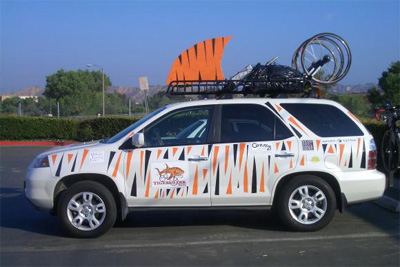
The Team TIGERSHARK MOBILE
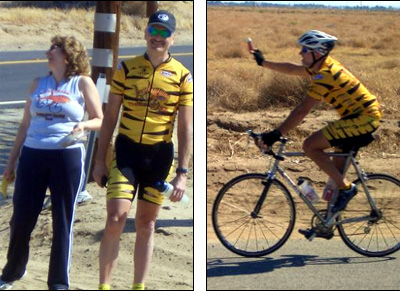
Crew Chief Jaymie ready to hand off (L), Dwayne done with some HammerGel (R)
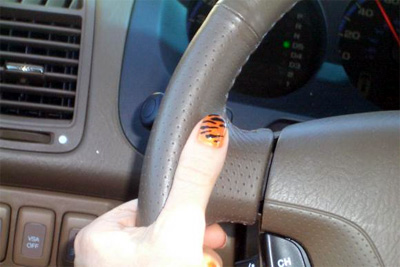
Team TigerShark Nails!
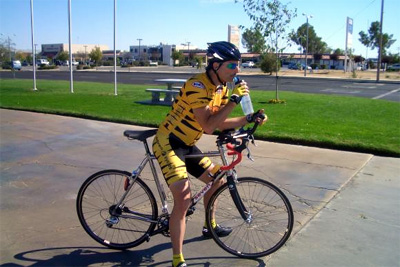
Tim waiting for handoff, California City
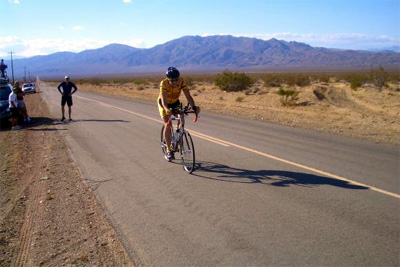
A lot of LONG roads in the desert
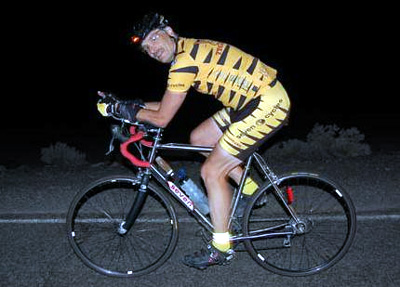
Death Valley close to Salsberry Pass
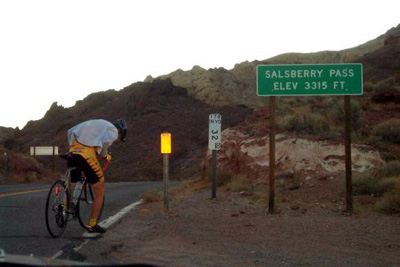
From -260 feet to the top in 16 miles
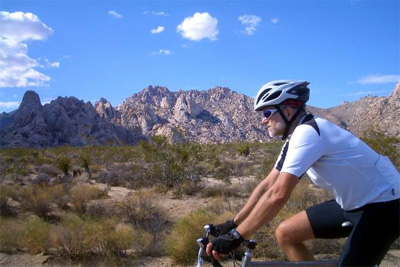
Dwayne (out of uniform) in the Mojave
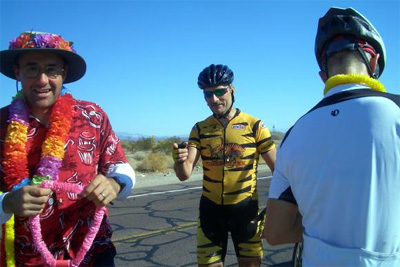
Tim to take last 55 mile stage
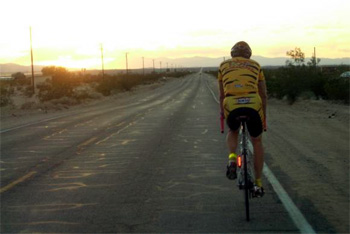
20 miles to the finish line
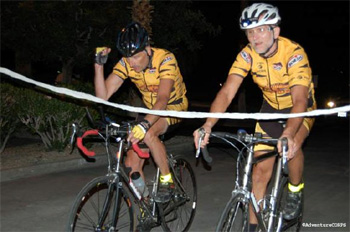
Finally, the finish!
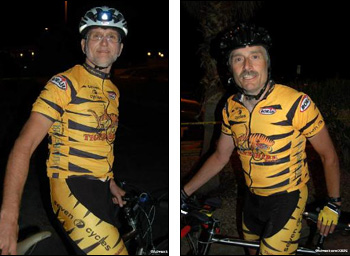
Two exhausted riders: Dwayne and Tim
The Furnace Creek 508 Through a TigerShark's Eyes
By Tim Jones
The 2006 edition of the prestigious Furnace Creek 508, the 508 mile bike race through California's Mojave Desert and Death Valley saw a record number of riders, 189, and unusually mild temperatures.
My teammate, Dr. Dwayne Highsmith and I have been riding and racing together for many years. This would be our second two-man team effort at Furnace Creek, the first taking place back in 2003 as Team Diamondback.
Since I have been racing as TigerShark for the past three years, and with the addition of sponsors identifying with the name, we decided to race as Team TigerShark.
Furnace Creek is the largest, and one of the most prestigious ultracycling events in the world. A number of years ago the race organizers decided racers would be given animal totems, sort of as their spiritual guides through this grueling race, instead of numbers. Totems are awarded to individual solo riders for life. I received the TigerShark totem in 2004.
The last time we raced Furnace Creek together, I started the race, so it was only fair that Dwayne get his turn.
Since 2003, the rules had changed. Back then, riders could make handoffs (exchanges) whenever they wanted to. Exchanges usually took place every 3-5 miles, making the race a speed contest, rather than one of pacing and endurance.
In 2004 the organizers changed the format so exchanges could only take place at the eight time stations along the course. This means mandatory stages for each rider of roughly 70-90 miles the first day, and 30-50 miles the second day, depending upon the distance between particular time stations.
Dwayne's first pull was 80 miles, up a significant hill at the beginning. His second pull would take him up the legendary Townes Pass, over 5,000 feet tall, and into Death Valley.
Dwayne followed our pre-race plan and didn't let the excitement of the ceremonial start cause him to bust a gut in the first 20 miles as I had done three years before. Instead he took a nice, steady pace and finished the first leg in 14th place.
Now, if only I had taken my own advice, the next 20 hours might have been more comfortable. Instead, Dwayne passed me the baton at California City and shot off like a bullet, moving us up five places by the time I'd hit the Randsburg Climb, and entering the almost-ghost town called Trona, the last gas station until the following day. The exciting, but unreasonably fast pace would catch up with me!
Our crew consisted of my wife and crew chief, Jaymie, and a good friend of ours, Rick Wood, who would be seeing ultra-cycling for the first time. Racing is every bit as stressful for the crew as it is for the racers and it takes a special blend of personalities to make a crew work. They are stuck in a car for 34 hours, following the racers, filling bottles, giving them information, listening to them whine, and in my case, occasionally watching them loose their lunch in the headlights, 4 miles from the finish. More on that later.
As night fell, Dwayne was on the longest pull of the race, just shy of 100 miles, and was less than an hour away from the start of Townes Pass. He was hurting. Thankfully, his legs came back in the bottom miles of the climb and he was able to keep a quick, steady pace up the mountain.
At the summit it was 20 degrees colder than in the valley. Jaymie suggest some hot soup was in order. She reached down from the passenger seat to plug in the 12-volt hotpot we use. Pow! The revolving yellow lights, that every crew vehicle is required to use when following their rider, went out, as did the radio and the GPS. We had blown a fuse somewhere in the team car.
Meantime, Dwayne was heading down the mountain at the traditional break-neck speed of 40+ mph. With no loudspeaker (it worked on the same fuse) we had no way to tell him to stop. Rick turned on the vehicle's flashers and we followed Dwayne to the valley floor where we could safely pull him over.
Five minutes later we located the blown 15 amp fuse and replaced it with a 30 amp fuse we stole from the power sunroof. We permanently put the hot pot away and continued on.
About 1 A.M. at Furnace Creek, the third time station located in the middle of Death Valley, I took over.
Something was wrong. I had a headache and the figures coming out of my computerized PowerTap rear hub said I should be putting out more power. Forty miles into my pull I hit the Jubilee and Salsberry climbs, which take us out of Death Valley.
The climb peaks at 3,300 feet, but you start at almost 300 feet below sea level, with a brief but steep decent in the middle, making the total climbing 4,500 feet in 15 miles.
That climb may have been the toughest two hours I've ever spent on a bike. The climb is unrelenting, it's the middle of the night, and the only thing you can see is what shows up in the headlights of the team car that's been on your wheel all night. And just to add insult to injury, a headwind came sweeping through the pass with about five miles still to go.
The crew knew I was hurting and wisely stayed quietly behind, letting me get into a kind of Zen rhythm. At daybreak I reached the summit.
Dwayne took over at the town of Shosone and headed for Baker. He was feeling good...really good, and he was flying toward the only town on the course with a Jack in the Box, or any fast food, at an amazing speed, passing other riders every couple of miles.
In Baker, it was my turn again to start slogging up the Kelbaker grade, nicknamed "Forever Grade," by racers. The climb is 14 miles long, not too steep, but out in the open sun. I have deep memories of suffering up this grade three years ago.
To my surprise, whatever good karma Dwayne had picked up was caught by me and as the crew left me to find some junk food, I got faster and faster as I climbed. I passed a number of racers and, because of the speed I was traveling, the crew actually got worried as they kept driving up the road and not finding me.
A mile from the summit of the climb I passed one of our arch rivals in the race, Team Skink. I had passed Skink on the floor of Death Valley the night before, only to have them charge back around ten minutes later and settle in right in front of me. I tried to re-pass, but every time I did they would speed up just enough that I couldn't get around their team van. It seemed that when I'd slow down, they'd slow down too. After trying three or four times, a race official came up and ordered me to position myself back the requisite 100 meters as required by the safety rules if you are unable to pass.
It was all fair play of course, after all this is a race, but it gave our team some motivation to make sure we were first to the finish line in Twentynine Palms.
Following the summit, we descended to the "town" of Kelso where Dwayne began his final pull. He put in another great effort which should have secured our position in the race.
The final time station in Amboy has a Hawaiian theme. The riders get lai'd and some pineapple juice. But I didn't stick around. Skink pulled in right behind us and I had the final 54 mile pull to the finish ahead of me.
I jumped on the aerobars and flew towards the last climb, Sheephole Mountain, some 20 miles away.
Well, I should have been cycling at a good, comfortable speed, but definitely not flying! After 15 miles I noticed my stomach just wasn't right.
By the time I crested Sheephole, I was downright sick! I drank water and hoped upon hope that the five mile descent to the last, relatively flat 20 miles would give my stomach a chance to recover...it didn't.
For me, the last 20 miles were miserable. What should be an exciting hour or so as you smell the finish approaching turned into a miserable, never ending churning of the pedals. It was like having to ride your bike as fast as you can, worrying all along that you're going to get passed, while at the same time you're sick as a dog with the stomach flu.
Finally, the crew announces that I'm approaching the left turn that will put me into Twentynine Palms, about four miles from the finish. I carefully make the turn across traffic, then hurriedly put the back of my hand on my butt (a sign to the crew that I'm stopping and please don't run me over), and just as I put my foot down I lost whatever it was I had in my stomach.
If the past 16 miles had been miserable, the last four were something worse. But with the help of the crew's guidance, we made no further stops until we were one block from the finish, at which time the rules allowed Dwayne to get on his bike too, so we could cross the finish together.
We crossed the line in 34 hours, 35 minutes, 4th place in our division and 9th place overall.
After the awards and pictures, I was just too sick to even go out to the celebratory dinner at the local pizza establishment. Jaymie took me to our hotel room, put me in bed, and the next thing I knew it was 3:30 A.M. and I was starving. Thankfully she had brought a slice of pizza back to the room in the event of a midnight miraculous recovery.
Notwithstanding the hard times, nothing unusual in ultra-distance racing anyway, Team TigerShark had a terrific time! We absolutely had the best crew any racer could hope for. Even in the dark moments, no one lost their sense of humor, perhaps the most important ingredient in any ultra-endurance race.